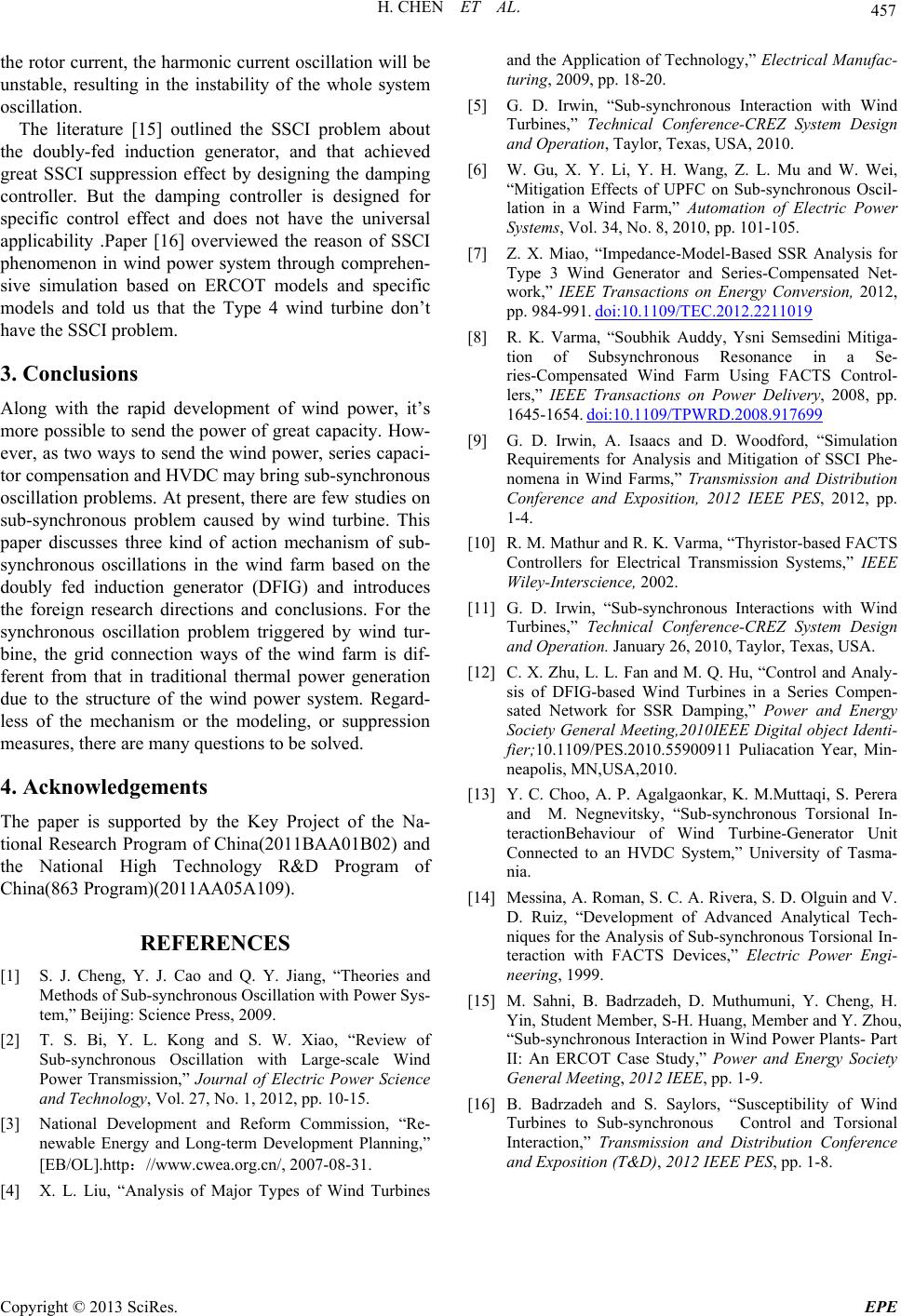
H. CHEN ET AL.
Copyright © 2013 SciRes. EPE
457
the rotor current, the harmonic current oscillation will b e
unstable, resulting in the instability of the whole system
oscillation.
The literature [15] outlined the SSCI problem about
the doubly-fed induction generator, and that achieved
great SSCI suppression effect by designing the damping
controller. But the damping controller is designed for
specific control effect and does not have the universal
applicability .Paper [16] overviewed the reason of SSCI
phenomenon in wind power system through comprehen-
sive simulation based on ERCOT models and specific
models and told us that the Type 4 wind turbine don’t
have the SSCI proble m.
3. Conclusions
Along with the rapid development of wind power, it’s
more possible to send the power of great capacity. How-
ever, as two ways to send the wind power, series capaci-
tor compensation and HVDC may bring sub-synchronous
oscillation problems. At present, there are few studies on
sub-synchronous problem caused by wind turbine. This
paper discusses three kind of action mechanism of sub-
synchronous oscillations in the wind farm based on the
doubly fed induction generator (DFIG) and introduces
the foreign research directions and conclusions. For the
synchronous oscillation problem triggered by wind tur-
bine, the grid connection ways of the wind farm is dif-
ferent from that in traditional thermal power generation
due to the structure of the wind power system. Regard-
less of the mechanism or the modeling, or suppression
measures, there are many questions to be solved.
4. Acknowledgements
The paper is supported by the Key Project of the Na-
tional Research Program of China(2011BAA01B02) and
the National High Technology R&D Program of
China(863 Program)(2011AA05A 109).
REFERENCES
[1] S. J. Cheng, Y. J. Cao and Q. Y. Jiang, “Theories and
Methods of Sub-synchronous Oscillation with Power Sys-
tem,” Beijing: Science Press, 2009.
[2] T. S. Bi, Y. L. Kong and S. W. Xiao, “Review of
Sub-synchronous Oscillation with Large-scale Wind
Power Transmission,” Journal of Electric Power Science
and Technology, Vol. 27, No. 1, 2012, pp. 10-15.
[3] National Development and Reform Commission, “Re-
newable Energy and Long-term Development Planning,”
[EB/OL].http://www.cwea.org.cn/, 2007-08-31.
[4] X. L. Liu, “Analysis of Major Types of Wind Turbines
and the Application of Technology,” Electrical Manufac-
turing, 2009, pp. 18-20.
[5] G. D. Irwin, “Sub-synchronous Interaction with Wind
Turbines,” Technical Conference-CREZ System Design
and Operation, Taylor, Tex as, USA, 2010.
[6] W. Gu, X. Y. Li, Y. H. Wang, Z. L. Mu and W. Wei,
“Mitigation Effects of UPFC on Sub-synchronous Oscil-
lation in a Wind Farm,” Automation of Electric Power
Systems, Vol. 34, No. 8, 2010, pp. 101-105.
[7] Z. X. Miao, “Impedance-Model-Based SSR Analysis for
Type 3 Wind Generator and Series-Compensated Net-
work,” IEEE Transactions on Energy Conversion, 2012,
pp. 984-991. doi:10.1109/TEC.2012.2211019
[8] R. K. Varma, “Soubhik Auddy, Ysni Semsedini Mitiga-
tion of Subsynchronous Resonance in a Se-
ries-Compensated Wind Farm Using FACTS Control-
lers,” IEEE Transactions on Power Delivery, 2008, pp.
1645-1654. doi:10.1109/TPWRD.2008.917699
[9] G. D. Irwin, A. Isaacs and D. Woodford, “Simulation
Requirements for Analysis and Mitigation of SSCI Phe-
nomena in Wind Farms,” Transmission and Distribution
Conference and Exposition, 2012 IEEE PES, 2012, pp.
1-4.
[10] R. M. Mathur and R. K. Varma, “Thyristor-based FACTS
Controllers for Electrical Transmission Systems,” IEEE
Wiley-Interscience, 2002.
[11] G. D. Irwin, “Sub-synchronous Interactions with Wind
Turbines,” Technical Conference-CREZ System Design
and Operation. January 26, 2010, Taylor, Texas, USA.
[12] C. X. Zhu, L. L. Fan and M. Q. Hu, “Control and Analy-
sis of DFIG-based Wind Turbines in a Series Compen-
sated Network for SSR Damping,” Power and Energy
Society General Meeting,2010IEEE Digital object Identi-
fier;10.1109/PES.2010.55900911 Puliacation Year, Min-
neapolis, MN,USA,2010.
[13] Y. C. Choo, A. P. Agalgaonkar, K. M.Muttaqi, S. Perera
and M. Negnevitsky, “Sub-synchronous Torsional In-
teractionBehaviour of Wind Turbine-Generator Unit
Connected to an HVDC System,” University of Tasma-
nia.
[14] Messina, A. Roman, S. C. A. Rivera, S. D. Olguin and V.
D. Ruiz, “Development of Advanced Analytical Tech-
niques for the Analysis of Sub-synchronous Torsional In-
teraction with FACTS Devices,” Electric Power Engi-
neering, 1999.
[15] M. Sahni, B. Badrzadeh, D. Muthumuni, Y. Cheng, H.
Yin, Student Member, S-H. Huang, Member and Y. Zhou,
“Sub-synchronous Interaction in Wind Power Plants- Part
II: An ERCOT Case Study,” Power and Energy Society
General Meeting, 2012 IEEE, pp. 1-9.
[16] B. Badrzadeh and S. Saylors, “Susceptibility of Wind
Turbines to Sub-synchronous Control and Torsional
Interaction,” Transmission and Distribution Conference
and Exposition (T&D), 2012 IEEE PES, pp. 1-8.